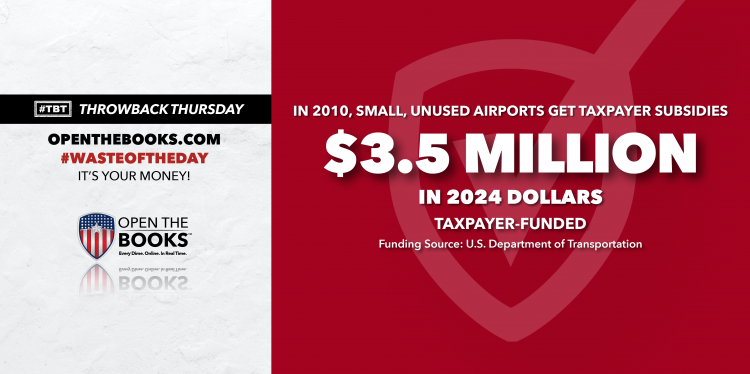Executive
Waste of the Day: Throwback Thursday: Sky-High Costs at Low Traffic Airports
The federal government’s airport subsidies pay for commercial flight routes that carry few passengers because people drive the distance.

Topline: Most commercial flights fly between cities where travel by car is infeasible. A flight to another close-by city in the same state seems less essential.
Subsidies for a tiny airport here and there
Yet the Department of Transportation spent up to $464 per passenger to subsidize otherwise unprofitable commercial flights between Macon and Athens, Georgia in 2010. The total cost was $2.4 million, or $3.5 million adjusted for inflation.
That’s according to the “Wastebook” reporting published by the late U.S. Senator Dr. Tom Coburn. For years, these reports shined a white-hot spotlight on federal frauds and taxpayer abuses.

Coburn, the legendary U.S. Senator from Oklahoma, earned the nickname “Dr. No” by stopping thousands of pork-barrel projects using the Senate rules. Projects that he couldn’t stop, Coburn included in his oversight reports.
Coburn’s Wastebook 2010 included 100 examples of outrageous spending worth more than $11.5 billion, including the money spent on Georgia’s airfare.
Key facts: A seat on a 50-minute flight between Macon and Athens cost passengers only $39 because the Essential Air Service program stepped in with federal funds to help cover the cost of flights to rural areas far away from “hub airports.”
“Far away” is a bit of a stretch: Macon and Athens are both less than 100 miles from the Hartsfield-Jackson International Airport in Atlanta, but the 90-minute drive was apparently too inconvenient for some residents.
Two unpopular airports
The Macon airport was so unpopular that ridership declined by 85% in a single year even after the federal government started paying part of riders’ fares. On average, 10 passengers flew out of the airport in one day.
The Athens airport had an average of 12 subsidized flights per day.
Background: Federal funding for the two niche airports continues today. Macon received $4.7 million annually as of 2022 and would have operated at a loss otherwise.
The cost of the Essential Air Service has soared as well. Subsidies nationwide cost $143 million in 2015 but more than doubled to $394 million in 2023.
Search all federal, state and local government salaries and vendor spending with the AI search bot, Benjamin, at OpenTheBooks.com.
Critical quote: “With Macon and dozens of others, Congress should consider replacing the Essential Air Service … with coach bus feeder service in communities within 150 air miles of a hub airport,” Marc Scribner, senior transportation policy analyst for the Reason Foundation, told The Center Square. “This could cut taxpayer costs by more than two-thirds and reduce carbon dioxide emissions by nearly three-quarters.”
Summary: All travelers want convenient and inexpensive flights, but taxpayers shouldn’t be subsidizing unprofitable commercial flights by for-profit companies.
The #WasteOfTheDay is brought to you by the forensic auditors at OpenTheBooks.com.
This article was originally published by RealClearInvestigations and made available via RealClearWire.
Jeremy Portnoy, former reporting intern at Open the Books, is now a full-fledged investigative journalist at that organization. With the death of founder Adam Andrzejewki, he has taken over the Waste of the Day column.
-

 Civilization3 days ago
Civilization3 days agoDC Pipe Bomb Arrest Raises Questions About Christopher’s Wray’s FBI
-

 Civilization4 days ago
Civilization4 days agoThe Legal Logic Behind U.S. Operations Against Narco-Terrorist Networks
-

 Guest Columns5 days ago
Guest Columns5 days agoCongressional Leaders See Far Higher Stock Returns Than Peers
-

 Civilization5 days ago
Civilization5 days agoHow Trump Changed America
-

 Executive4 days ago
Executive4 days agoNewsom’s ‘National Model’ for Homeless Wracked by Fraud
-

 Executive3 days ago
Executive3 days agoWhen You’re in a Hole, Stop Digging
-

 Education2 days ago
Education2 days agoWaste of the Day: Taxpayers Subsidize Football Coach Severance
-

 Civilization2 days ago
Civilization2 days agoPence Calls on Trump To Fire RFK Jr Over Abortion Drug












